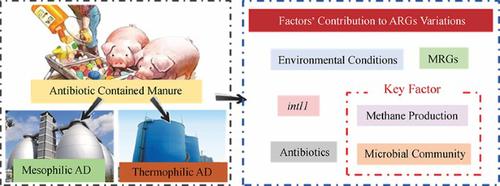Frontiers of Environmental Science & Engineering ( IF 6.4 ) Pub Date : 2020-12-30 , DOI: 10.1007/s11783-020-1342-x Qinxue Wen , Shuo Yang , Zhiqiang Chen

|
The role of norfloxacin (NOR) and sulfamethoxazole (SMX) in mesophilic and thermophilic anaerobic digestion (AD) of pig manure, with respect to methane production and variations in the microbial community and resistance genes, including antibiotic resistance genes (ARGs), class I integrase (intIl), and heavy metal resistance genes (MRGs), was investigated. The results indicated that NOR exerted little influence on the microbial community, whereas SMX negatively affected the acetoclastic methanogens. The abundance of two sulfonamide resistance genes (sul1 and sul2), three quinolone resistance genes (qnrS, parC, and aac(6′)-Ib-cr), and intI1 decreased by 2–3 orders of magnitude at the end of thermophilic AD. In contrast, mesophilic AD was generally ineffective in reducing the abundance of resistance genes. According to the results of redundancy analysis, the abundance of ARGs was affected primarily by microbial community dynamics (68.5%), rather than the selective pressure due to antibiotic addition (13.3%). Horizontal gene transfer (HGT) through intI1 contributed to 26.4% of the ARG variation. The archaeal community also influenced the changes in the resistance genes, and ARG reduction was significantly correlated with enhanced methane production. Thermophilic AD presented a higher methane production potential and greater reduction in resistance gene abundance.
中文翻译:

磺胺甲基异恶唑和诺氟沙星对猪粪的中温和厌氧消化:微生物群落的动态和耐药基因的演变
诺氟沙星(NOR)和磺胺甲恶唑(SMX)在猪粪的嗜温和嗜热厌氧消化(AD)中的作用,涉及甲烷产生,微生物群落和耐药基因(包括抗生素耐药基因(ARG))的甲类变异研究了整合酶(intll)和重金属抗性基因(MRGs)。结果表明,NOR对微生物群落影响不大,而SMX对乙酰碎屑产甲烷菌有负面影响。两个磺酰胺抗性基因(sul1和sul 2),三个喹诺酮抗性基因(qnrS,parC和aac(6')-Ib-cr)和intI1的丰度在嗜热性AD结束时下降了2-3个数量级。相反,嗜温性AD通常在减少抗性基因的丰度方面无效。根据冗余分析的结果,ARG的丰度主要受微生物群落动态的影响(68.5%),而不是由于添加抗生素引起的选择性压力(13.3%)。通过intI1进行的水平基因转移(HGT)占ARG变异的26.4%。古细菌群落也影响抗性基因的变化,并且ARG的降低与甲烷产量的增加显着相关。嗜热性AD表现出更高的甲烷生产潜力,并大大降低了抗性基因丰度。


























 京公网安备 11010802027423号
京公网安备 11010802027423号